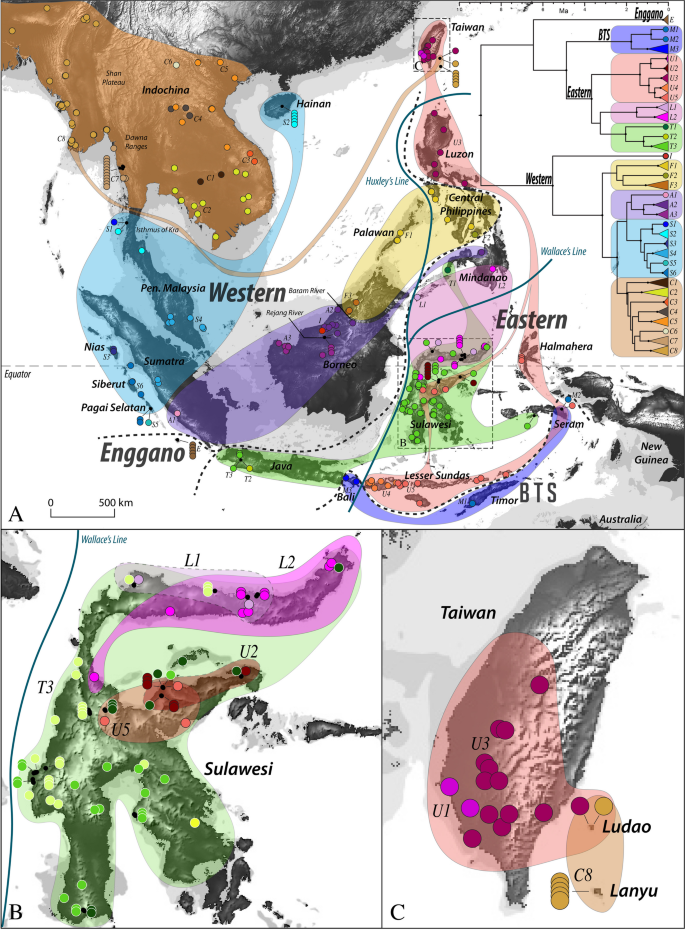The natural and human-mediated expansion of a human-commensal lizard into the fringes of Southeast Asia
IF 3.4
Q1 Agricultural and Biological Sciences
引用次数: 0
Abstract
Human-commensal species often display deep ancestral genetic structure within their native range and founder-effects and/or evidence of multiple introductions and admixture in newly established areas. We investigated the phylogeography of Eutropis multifasciata, an abundant human-commensal scincid lizard that occurs across Southeast Asia, to determine the extent of its native range and to assess the sources and signatures of human introduction outside of the native range. We sequenced over 350 samples of E. multifasciata for the mitochondrial ND2 gene and reanalyzed a previous RADseq population genetic dataset in a phylogenetic framework. Nuclear and mitochondrial trees are concordant and show that E. multifasciata has retained high levels of genetic structure across Southeast Asia despite being frequently moved by humans. Lineage boundaries in the native range roughly correspond to several major biogeographic barriers, including Wallace’s Line and the Isthmus of Kra. Islands at the outer fringe of the range show evidence of founder-effects and multiple introductions. Most of enormous range of E. multifasciata across Southeast Asia is native and it only displays signs of human-introduction or recent expansion along the eastern and northern fringe of its range. There were at least three events of human-introductions to Taiwan and offshore islands, and several oceanic islands in eastern Indonesia show a similar pattern. In Myanmar and Hainan, there is a founder-effect consistent with post-warming expansion after the last glacial maxima or human introduction.

一种与人类共生的蜥蜴在自然和人为因素的作用下向东南亚边缘地区扩张
与人类共生的物种通常在其原生地表现出深远的祖先遗传结构,而在新建立的地区则表现出始祖效应和/或多次引入和混杂的证据。Eutropis multifasciata是一种广泛分布于东南亚的与人类共生的鳞蜥,我们对其系统地理学进行了研究,以确定其原生地的范围,并评估原生地以外的人类引入的来源和特征。我们对超过 350 个 E. multifasciata 样本进行了线粒体 ND2 基因测序,并在系统发育框架内重新分析了之前的 RADseq 群体遗传数据集。核树和线粒体树是一致的,表明尽管多袋蛙经常被人类迁徙,但在整个东南亚地区仍保留了高度的遗传结构。原生地的世系边界与几个主要的生物地理屏障大致对应,包括华莱士线和克拉地峡。分布区外围的岛屿显示了始祖效应和多次引入的证据。E.multifasciata在东南亚的大部分巨大分布区都是原生的,只有在其分布区的东部和北部边缘地带才有人类引入或近期扩展的迹象。台湾和近海岛屿至少发生过三次人类引入事件,印度尼西亚东部的几个海洋岛屿也有类似情况。在缅甸和海南,有一种始祖效应,与上一个冰川极盛期后气候变暖或人类引入后的扩张一致。
本文章由计算机程序翻译,如有差异,请以英文原文为准。
求助全文
约1分钟内获得全文
求助全文
来源期刊

BMC Evolutionary Biology
生物-进化生物学
CiteScore
5.80
自引率
0.00%
发文量
0
审稿时长
6 months
期刊介绍:
BMC Evolutionary Biology is an open access, peer-reviewed journal that considers articles on all aspects of molecular and non-molecular evolution of all organisms, as well as phylogenetics and palaeontology.
 求助内容:
求助内容: 应助结果提醒方式:
应助结果提醒方式:


